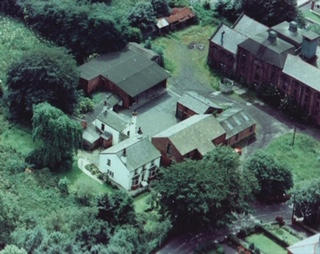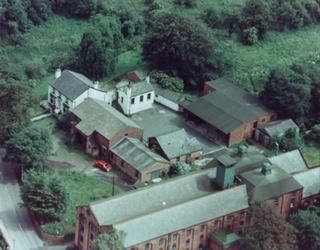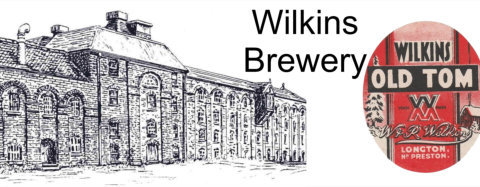

LongtonOnline.co.uk



Wilkins Brewery
My maiden name was Janette Wilkins and I am 3rd Great Grand-daughter to Thomas Wilkins and Ellen Southworth who founded the Brewery, Marsh Lane Longton. I would love to hear from anyone with news of any ancestors. - info@longtononline.co.uk
Wilkins ancestry
During the first covid-19 lockdown I had time on my hands to dig deeper into my ancestry that my son, Dan, started in 2011.
My great great great paternal grandfather was Thomas Wilkins born in Longton 22/08/1779. He married Ellen Southworth (born
16/11/1777) in St Mary’s Church, Penwortham 05/01/1801.
The couple immediately moved into The Golden Ball, Longton.
They had 4 children, William (b 1807), Richard (b 1816), Henry (b 1818) and Mary (b1820).
Around the early 1800s it was usual for inn-keepers to brew their own beer, so in 1804, Thomas Wilkins operated his malting business
with his brother in law John Southworth and purchased land and properties close to the Golden Ball. He leased a farm house with 31
acres down Marsh Lane and built a malt kiln. This is now the cul de sac called The Maltings which has residential properties. He also
built a reservoir for essential water supply at the rear.
By 1817 the business was thriving, employing over 12 men and by 1827 Wilkins and Southworth were by far the largest suppliers of malt,
together with a small quantity of hops to the Farington family estate at Worden Hall, Leyland.
A smaller brewery company called Pye’s was also established a little further down Marsh Lane.
By 1838 Thomas and Ellen owned 5 properties including an inn originally called The Mermaid, now known as The Dolphin or Flying Fish
at the far end of Marsh Lane (coincidentally, my step-father was born her March 1936) and Plumpton House, Marsh Lane (next to The
Maltings).
Thomas was an integral part of Longton life throughout his adulthood and, apart from his malting, brewing and farming interests, he
had been closely involved with the Ribble Navigation Company as their Longton agent, in the reclamation of the marsh resulting from
the straightening of the river channel. He was also involved with poor-relief and the running of the Longton work-house.
Thomas dies 30/12/1841 age 62. His wife Ellen continued to live at Plumpton House, Marsh Lane until her death in 1850.
Her two eldest sons, William and Richard, took over the business.
William was the eldest and more retiring and unobtrusive in character than Richard
and continued to live at Plumpton House, Marsh Lane and in 1853, aged 46, he
married Ann Hunt, (from The Black Horse, Hoole). William was a keen participant in
country pursuits of shooting and fishing. In 1866, he owned the majority of shares of
the salmon fisheries on the rivers Douglas and Ribble for over 50 years.
By contrast, his younger brother Richard was more outgoing, being involved in many
aspects of local life. He helped fund the Wesleyan Methodist movement. From 1837
he was superintendent of their Sunday school on Marsh Lane and provided funds for a
new chapel built in1872. In 1878 he was appointed a governor of Hutton Grammar
School, Hutton (where our son Daniel was a pupil from 2004).
In 1846, age 30, Richard married Deborah Naylor daughter of Thomas Naylor a tailor in
Preston. She died only 8 years later, shortly after giving birth to their son, Thomas
Richard. Three years later, Richard remarried, his wife being Mary Calvert, daughter
of William Calvert, the cotton magnate of Walton-le-Dale. In 1871 Richard and Mary and son (Thomas Richard) moved to “The Grove” a
large mansion on Liverpool Road, Longton (now demolished to make way for
housing). The Grove was a substantial elegant house with 6 acres and was the
venue for church and Sunday school walking days as well as local ‘Club Day’
processions.
William died in 1875 age 68, leaving the running of the business in the hands of
brother Richard, whose son Thomas Richard now became brewery manager. By
1881 age 64, Richard took a back seat although he was still very active.
1882 saw the arrival of the railway, with the opening of Longton Bridge Station on
the newly constructed West Lancashire Railway from Southport to Preston. This
greatly improved communication with both towns, and provided additional
impetus for expansion.
Richard Wilkins died Oct 1884 age 68. The running of the business passed to his
son Thomas Richard (b 1854).
Thomas Richard had been educated at Hutton Grammar School, Hawkshead
Grammar School and Cheltenham College. He took his father’s place as a governor of Hutton Grammar School and for over 40 years was
chairman of the Longton branch of the Fylde Conservative Association. In 1881, age 27, he married Fanny Taylor of Blundellsands.
By now the profits from the brewery enabled them to by land on a large scale, in Longton and Little Hoole. By 1884 they owned 3 large
farms: Odd House Farm (now Taylors plants, Hall Carr Lane, Hoole, Marsh House Farm, Station Road, Little Hoole and across the road
from it Lesser Marsh House Farm. The census in 1891 shows the Wilkins family owned 200 acres and over 30 properties, making them
the second largest landowners in Longton village.
The Wilkins brewery business reached its peak in the 1920s with some 20 outlets, mainly in Longton and the immediate area but also in
Preston and Southport. The Golden Ball was regarded as the ‘brewery tap’ and others included the Walmer Bridge Hotel, The Longton
Arms, The Dolphin, The Rose and Crown in Hoole. A boom in seaside holidays brought many travellers by coach via the A59, so in 1927
architect Christopher Wilkins (son of Thomas Richard) submitted a planning application for The Rose and Crown at Hoole to have an
extension plus ladies and gents toilets in the car park. Thomas Richard died April 1927 after a long illness, just 3 months before his son’s
building-application was successful.
After Thomas Richard’s death, the family sold most of their land in Longton and Hoole, including The Grove, but continued to run the
brewery business with his son, Thomas, as manager at Plumpton House.
Smaller, independent breweries were now being consolidated and swallowed up by larger concerns. By 1952 only W&R Wilkins was left
but was soon bought out by Salford brewery Groves and Whitnall, (said to be the model for Coronation Street’s Newton and Ridley).
Groves and Whitnall themselves would later be taken over by Greenall Whitley.





Wilkins Brewery
My maiden name was Janette Wilkins and I am 3rd Great Grand-daughter to Thomas Wilkins and Ellen Southworth who founded the Brewery, Marsh Lane Longton. I would love to hear from anyone with news of any ancestors. - info@longtononline.co.uk
Hewitson



Wilkins ancestry
During the first covid-19 lockdown I had time on my
hands to dig deeper into my ancestry that my son, Dan,
started in 2011.
My great great great paternal grandfather was Thomas
Wilkins born in Longton 22/08/1779. He married Ellen Southworth (born
16/11/1777) in St Mary’s Church, Penwortham 05/01/1801.
The couple immediately moved into The Golden Ball, Longton.
They had 4 children, William (b 1807), Richard (b 1816), Henry (b 1818)
and Mary (b1820).
Around the early
1800s it was usual
for inn-keepers to
brew their own beer,
so in 1804, Thomas
Wilkins operated his
malting business
with his brother in
law John Southworth
and purchased land
and properties close
to the Golden Ball.
He leased a farm house with 31 acres down Marsh Lane and built a malt
kiln. This is now the cul de sac called The Maltings which has residential
properties. He also built a reservoir for essential water supply at the rear.
By 1817 the business was thriving, employing over 12 men and by 1827
Wilkins and Southworth were by far the largest suppliers of malt, together
with a small quantity of hops to the Farington family estate at Worden
Hall, Leyland.
A smaller brewery company called Pye’s was also established a little
further down Marsh Lane.
By 1838 Thomas and Ellen owned 5 properties including an inn originally
called The Mermaid, now known as The Dolphin or Flying Fish at the far
end of Marsh Lane (coincidentally, my step-father was born her March
1936) and Plumpton House, Marsh Lane (next to The Maltings).
Thomas was an integral part of Longton life throughout his adulthood and,
apart from his malting, brewing and farming interests, he had been
closely involved with the Ribble Navigation Company as their Longton
agent, in the reclamation of the marsh resulting from the straightening
of the river channel. He was also involved with poor-relief and the
running of the Longton work-house.
Thomas dies
30/12/1841 age 62. His
wife Ellen continued to
live at Plumpton
House, Marsh Lane
until her death in
1850.
Her two eldest sons,
William and Richard,
took over the business.
William was the eldest
and more retiring and
unobtrusive in
character than Richard
and continued to live at Plumpton House, Marsh Lane and in 1853, aged
46, he married Ann Hunt, (from The Black Horse, Hoole). William was a
keen participant in country pursuits of shooting and fishing. In 1866, he
owned the majority of shares of the salmon fisheries on the rivers Douglas
and Ribble for over 50 years.
By contrast, his younger brother Richard was more outgoing, being
involved in many aspects of local life. He helped fund the Wesleyan
Methodist movement. From 1837 he was superintendent of their Sunday
school on Marsh Lane and provided funds for a new chapel built in1872. In
1878 he was appointed a governor of Hutton Grammar School, Hutton
(where our son Daniel was a pupil from 2004).
In 1846, age 30, Richard married Deborah Naylor daughter of Thomas
Naylor a tailor in Preston. She died only 8 years later, shortly after giving
birth to their son, Thomas Richard. Three years later, Richard remarried,
his wife being Mary Calvert, daughter of William Calvert, the cotton
magnate of Walton-le-Dale. In 1871 Richard and Mary and son (Thomas
Richard) moved to “The Grove” a large mansion on Liverpool Road,
Longton (now demolished to make way for housing). The Grove was a
substantial elegant house with 6 acres and was the venue for church and
Sunday school walking days as well as local ‘Club Day’ processions.
William died in 1875 age 68, leaving the running of the business in the
hands of brother Richard, whose son Thomas Richard now became
brewery manager. By 1881 age 64, Richard took a back seat although he
was still very active.
1882 saw the arrival of the railway, with the opening of Longton Bridge
Station on the newly constructed West Lancashire Railway from Southport
to Preston. This greatly improved communication with both towns, and
provided additional impetus for expansion.
Richard Wilkins died Oct 1884 age 68. The running of the business passed
to his son Thomas Richard (b 1854).
Thomas Richard had been educated at Hutton Grammar School,
Hawkshead Grammar School and Cheltenham College. He took his father’s
place as a governor of Hutton Grammar School and for over 40 years was
chairman of the Longton branch of the Fylde Conservative Association. In
1881, age 27, he married Fanny Taylor of Blundellsands.
By now the profits from the brewery enabled them to by land on a large
scale, in Longton and Little Hoole. By 1884 they owned 3 large farms: Odd
House Farm (now Taylors plants, Hall Carr Lane, Hoole, Marsh House
Farm, Station Road, Little Hoole and across the road from it Lesser Marsh
House Farm. The census in 1891 shows the Wilkins family owned 200 acres
and over 30 properties, making them the second largest landowners in
Longton village.
The Wilkins brewery business reached its peak in the 1920s with some 20
outlets, mainly in Longton and the immediate area but also in Preston and
Southport. The Golden Ball was regarded as the ‘brewery tap’ and others
included the Walmer Bridge Hotel, The Longton Arms, The Dolphin, The
Rose and Crown in Hoole. A boom in seaside holidays brought many
travellers by coach via the A59, so in 1927 architect Christopher Wilkins
(son of Thomas Richard) submitted a planning application for The Rose
and Crown at Hoole to have an extension plus ladies and gents toilets in
the car park. Thomas Richard died April 1927 after a long illness, just 3
months before his son’s building-application was successful.
After Thomas Richard’s death, the family sold most of their land in
Longton and Hoole, including The Grove, but continued to run the
brewery business with his son, Thomas, as manager at Plumpton House.
Smaller, independent breweries were now being consolidated and
swallowed up by larger concerns. By 1952 only W&R Wilkins was left but
was soon bought out by Salford brewery Groves and Whitnall, (said to be
the model for Coronation Street’s Newton and Ridley). Groves and
Whitnall themselves would later be taken over by Greenall Whitley.























































